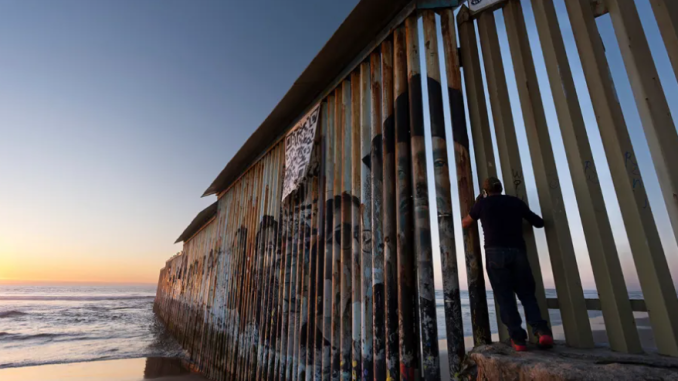
President Trump is sending hundreds of troops to the southern border for a wide-ranging mission that poses new challenges and raises questions about the military’s role in handling migration, traditionally a law enforcement responsibility.
Until now, troops have mainly supported Customs and Border Protection (CBP) with logistics, detection and monitoring and transportation. But Trump has vastly expanded the role of the military at the U.S.-Mexico border.
The 1,500 active-duty troops heading to the border will work on new tasks like deportation flights and constructing temporary and permanent physical barriers, along with intelligence collection.
{snip}
Trump also signed an executive order directing U.S. Northern Command to draft detailed operational plans for the border. That directive came in an order declaring an “invasion” at the border.
The greater role of American troops has sparked questions about what dangers a more involved military will present to migrants and public security.
While a senior military official said troops will not be carrying out law enforcement duties, they also will likely be carrying arms, raising the risk that soldiers trained to kill could fire on migrants.
It’s a major concern for immigration advocates inside and outside of Congress.
{snip}
The Pentagon is sending around 1,000 Army soldiers and 500 Marines. A U.S. military official said Thursday evening they were already on the way and expected deployment within two days.
The new detachment brings the total troop levels up to 4,000 at the border. A senior defense official said as many as 10,000 could be deployed in the future, though the official cautioned it was not a final number.
While the military is allowed to support law enforcement and has done so at the border previously, the move raises questions about whether growing military involvement could run afoul of the Posse Comitatus Act, which bars troops from domestic law enforcement duties.
Tony Payan, executive director of the Center for the U.S. and Mexico at Rice University, said he did not have major concerns about 1,500 troops but raised the alarm about sending up to 10,000, which he said would be a risk to migrants and “to public support for the military.”
Payan said having a smaller number of troops deployed would not violate the Posse Comitatus Act but a larger contingent would mean they play more than a supporting role to CBP and would likely be illegal.
{snip}
The troops will be augmenting Joint Task Force North, which is based out of Fort Bliss, Texas, and has been operating at the border for years with primarily National Guard troops.
Active-duty troops have been sent to the border before, including under former President Biden. The opening move from Trump and the promise of more deployments indicate the border will become increasingly militarized.
Immigration rights groups argue such action is the wrong approach.
“Asylum as we know it at our southern border is dead,” said Jorge Loweree with the American Immigration Council, referring to the process by which migrants arrive at the border to seek protection from persecution.
“The number of people arriving at the border is at the lowest level in years and will likely continue to decline as the word spreads. Militarizing the southern border won’t do anything to fix the problems that have plagued our immigration system for years, while also managing to waste an extraordinary amount of resources.”
Stephanie Brewer, director for Mexico at the Washington Office on Latin America, said in an email that migrants often arrive traumatized or disoriented and “to place combat-ready troops into direct contact with these vulnerable families and individuals creates a risk of human rights abuses in any case.”
{snip}
Goitein described the president’s series of executive orders as “a bit of a mess,” leaving unclear whether Trump is using the term “invasion” as a legal justification or rhetorically.
“It’s hard to tell whether this is just sort of a confusion about the law or if this is a deliberate attempt to try to collapse the separate categories of war and law enforcement,” she told The Hill.
“It’s sad that it even needs to be said out loud, but unlawful immigration is not an act of war, and it does not trigger war powers,” she said, adding that doing so would be “way off base legally.”
“They don’t do a good job of trying to match what he’s doing to specific legal authorities,” she said of the orders.
White House press secretary Karoline Leavitt told reporters Wednesday that Trump’s goal was to ensure the military “actually take homeland security seriously,” claiming it was a priority for the American people.
{snip}
The troops will support the Department of Homeland Security in deporting more than 5,000 migrants detained by authorities from San Diego, Calif., and El Paso, Texas.
That represents a shift, as removal flights are typically carried out by U.S. Immigration and Customs Enforcement (ICE) through ICE Air Operations, relying on commercial airlines and chartered flights to remove migrants.
Observers have also raised serious questions about troops trying to land migrants in other countries that might not accept U.S. military aircraft.
The military’s role in constructing barriers may also become an issue. Trump’s first-term effort to build a wall along the 2,000-mile border only saw about 458 miles of barrier construction completed — with just 52 of those miles new construction rather than replacements. Around 700 miles elsewhere along the border have some type of barrier.
Lila Abed, director of the Mexico Institute at the Wilson Center, said using the military can politicize issues further but explained Trump was likely trying to send a “political image” about the border.
“This is what the border looks like under [the Trump] administration, which is a clear signal to migrants from their countries to not go to the U.S.-Mexico border, because now the military is there,” she said.
Trump’s push to address the migrant crisis comes as border numbers declined in the final months of the Biden administration. The number of crossings dropped 81 percent in December compared to a year prior, with CBP reporting 47,330 encounters between ports of entry.
{snip}
“I don’t think that currently, we are witnessing an emergency,” she said. “It’s more of a preventative measure to avoid migrants crossing the U.S.-Mexico border.
“But also instilling this initial fear and using the momentum with the executive orders and with Trump’s return to the White House to send a message to different Latin American countries and beyond that it will become increasingly uncomfortable for migrants to try to enter the U.S.”
* Original Article:
https://thehill.com/policy/defense/5104027-trump-escalates-military-role-southern-border/
